

USMLE pharmacology is typically worth 40+ points on Step 1. With pathology, physiology, and immuno/micro, it is one of the most important subjects. Thus, how you approach mastering pharmacology will go a long way to determining your final score.
As we’ve discussed elsewhere, so much of the USMLEs focus on the application of knowledge. Unlike many med school exams, it’s not enough to know a particular fact on the USMLEs. Test-writers write questions that can’t be easily crammed. You have to be able to apply the concept.
However, USMLE pharmacology is different. Much of USMLE pharmacology revolves around knowing the basic information. There are many application-type questions for USMLE drugs. However, many items require basic information like mechanisms and side effects. In other words, the more you know, the higher your score will be.
How to Master Pharmacology in the Least Amount of Time Possible
In this article, you will learn:
- Why it’s critical to start pharmacology as soon as possible. (And why most people procrastinate).
- The six steps to create an awesome pharmacology deck or cards in the shortest time possible
- Specific examples of how to create pharmacology flashcards
- When the best time to make (and review) your high-yield pharm flashcards
- Much more
Note: this deals explicitly with learning the drugs for Step 1, Step 2, and Step 3. For pharmacology principles, you can use the basic principles of flashcard making here. USMLE pharmacology principles would involve things like competitive inhibitors, kinetics curves, etc.
Are you stressed with how little time you have to learn pharmacology? To master USMLE pharmacology in even less time, you can see the Yousmle Pharmacology deck here.
USMLE Pharmacology: 3 Things to Know
Before we start, here are 3 things to know to master pharmacology in the least time possible.
1. USMLE Pharmacology = Free Points
USMLE pharmacology can be boiled down to two main points:
- Pharmacology is worth a lot of Step 1 points
- You can get many of those points by knowing a large volume of knowledge
So how do you learn a large volume of knowledge? By using spaced repetition. I’d recommend using Anki to make flashcards, which is simple and – if you use the desktop app – free.
Making cards is so simple you can do so while drinking a glass of wine.
2. You Have to Start Early
Many students’ biggest regret is not starting pharmacology early on. There are plenty of good excuses not to start.
- “I’m too busy.”
- “There’s so much to learn; I don’t know where to start.”
- “I’ll forget everything anyway, so why bother?”
It’s natural to avoid hard things. However, the more you delay learning pharm, the more painful it will be when you start.
They say the best time to plant a tree was ten years ago. The second best time? Right now.
3. A Little Bit Over a Long Time >> Cramming
How do you eat an elephant? You do it bit by bit.
Learning USMLE pharmacology is the same thing. Instead of trying to eat the entire elephant at once, you need to do a little every day.
Anki makes continuous learning easy. Either make your own Anki cards or use the Yousmle Pharmacology Deck. Then, do a small number of flashcards every day.
The Yousmle Pharmacology Deck has ~1800 cards in it. Thus, if you had 90 days, if you did only 20 new cards/day, you could get through the entire deck.
5 Steps to Make USMLE-Crushing Pharmacology Flashcards
Here are the steps to making your own high-yield USMLE pharmacology cards.
1. “Copy + Paste” From an Electronic Resource
Knowing First Aid pharmacology is sufficient for getting the most questions correct. Of course, First Aid isn’t the only source for USMLE pharmacology. (You can find the information presented in a more straightforward form in the Yousmle Pharmacology Deck). However, if you want to make your own Anki flashcards, First Aid is a great place to start.
First, get a copy of First Aid for the USMLE Step 1. Note: I HIGHLY recommend getting an electronic copy like the Kindle copy linked to here. The “copy + paste” functionality will save you LOTS of time.
Second, decide which drugs you will cover. Choosing what drugs you want to start with may sound simple. However, given pharmacology can be so overwhelming, having a jumping-off point is a huge step.
Are you are still in the classroom-portion of medical school (i.e., not yet in dedicated Step 1 mode)? If so, the drugs you choose should be part of the organ system/block you are currently in. Identify the “pharmacology” section for that system in First Aid. Organ system drugs are typically the last section per organ block. For example, if I was studying cardiology, I would turn to the back of the cardiology section:
2. Make Simple USMLE Pharmacology Cards to Save Time and Improve Retention
Next, make separate forward AND reverse cards for “mechanism,” “clinical use,” and “toxicity.” Making forward/reverse cards means that you will likely have at least six cards per drug.
You should have more but simpler cards. For example, “(Drug) – mechanism,” “(Drug) – use,” and “(Drug) – toxicity,” with appropriate reverse cards. Then, on the opposite side, I will use my electronic copy of FA to copy/paste the information into my card.
What the $β↑α% Happened to My Symbols?
In Anki, this would look like:
Anki struggles to recognize symbols from electronic resources, particularly pdfs. Instead of having nice symbols like ↑ or →, I end up with things like atomic death. If this happens, you can use text expander programs like aText. I can replace all the symbols quickly to their original form. Using these symbols gives you more legible cards that will speed your reviews.
3. Check the “Add Reverse” Box for Better Cards in Less Time
Note that I put a “y” in the “Add Reverse” text box. The “Add Reverse” box lets you make a reverse card.
A “Forward” card means that the front box (i.e. “Hydralazine – mechanism”) is the question. The back box (“↑ cGMP → smooth muscle relaxation…”) is the answer.
A “Reverse” card is the opposite. The back box is now the question, and the front is now the answer. In this case, I’d have to identify the drug from the mechanism itself.
Your Exam Will Test Information in Both “Directions.” Your Cards Should Prepare You For This.
Why is it important to make reverse cards? Because most Step 1 pharmacology questions test your basic knowledge about these drugs. Some will ask you the name of the drug after identifying the mechanism. Others will ask the toxicity while giving you the name.
In other words, they may ask you the equivalent of either a “forward” or a “reverse” Anki question. Make your Anki cards accordingly, to deal with any such scenario.
So far, we’ve made 2 cards (a mechanism card, in both “forward” and “reverse” directions). We repeat the process until we have “forward” and “reverse” cards for “clinical use” and “toxicity.” This gives us a total of at least 6 cards per drug.
Applying the same “Copy and Paste” to this, the two “drug uses” cards would look something like this:
Reverse Cards Prevent USMLE Pharmacology Information Overload
A basic tenet of making Anki cards is not to overload your cards with too much information. My rule is to have no more than 2-3 unrelated facts tested at one time.
Despite bolding the important information, many pharm cards have too much information. One place this shows up is the level of difficulty between the forward and reverse questions. The forward question is significantly more difficult than the reverse question.
To answer the forward question, I need to recall hydralazine is used for hypertension and CHF. I’d need to remember it’s used for hypertension in pregnancy. And don’t forget that β blockers can prevent reflex tachycardia (4 facts).
While the forward direction is very challenging, the reverse direction is much easier. I would just have to recall one of those facts to recall that the drug is hydralazine (1 fact).
How can I make these cards easier to recall? By balancing the difficulty of facts to recall.
4. Balance the Difficulty of the “Forward” and “Reverse” Directions
The forward card is usually harder than the reverse card. To improve recall of USMLE pharmacology, try and balance those difficulties.
I like to rate cards from a 1-10. “1” means the card is so simple I could remember it even without Anki. A “10” would be so complicated it’d be like memorizing the opening to Canterbury Tales.
Let’s look at the above case to see how this works in practice. I would rate the “forward” question “Hydralazine – uses” as roughly a 7. It’s hard to remember all these uses together.
I would rate the “reverse” question of “(uses) – drug?” as a 2. I prefer the forward and reverse cards have equal difficulty. Remember, every time we forget an Anki card, our studying will take longer. Balancing difficulties reduces the number of unnecessary repetitions.
In this case, I would re-write the card to the following:
Remind Yourself the Number of Facts to Recall
Notice that now, the forward question is easier, as there are only three things to remember. Additionally, I made it easier by reminding myself that there will be three things (3) to recall in the future.
If you’ve used Anki before, this will be a familiar problem. Of a list of three things, you’ll recall two of them but will forget the last one. It’s not that you forgot that fact, to begin with. Had you known there were three items to remember, you’d know all three. However, by not knowing how many things you need to know, you’ll forget the last one.
So what do you do? Remind yourself of how many items you need to remember.
5. Explain “Why” When Possible
Finally, whenever possible, explain “why” something is. I added a brief explanation for why it would make sense to coadminister with β blockers. (Hydralazine will lead to hypotension, which will lead to increased sympathetic tone. To block the reflex tachycardia, you can use β blockers).
Why add explanations? First, remember, the goal of USMLE question-writers is to assess understanding, NOT memorization. Many questions will test your ability to apply knowledge, not simple recall. Additionally, knowing “why” helps with simple recall, as well.
Applying the Same Principles to Drug Toxicities
Now, let’s try the same thing with drug toxicities. The basic “Copy + Paste” approach yields us this:
Here, we have the same problems as before: too much information and unbalanced cards. The solutions are the same.
First, we make sense of as many symptoms as possible. Then we try and balance out the difficulties of the cards in either direction.
Balancing the Difficulties of the Forward/Reverse Directions
Balancing the forward and reverse directions’ difficulties would give us cards like this:
Here, I have grouped the adverse effects I can connect. An afterload reducer will lead to reflex sympathetic effects. (I am not blocking sympathetic receptors like I am w/ β blockers). When my baroreceptors sense decreased BP, sympathetic tone increases. Reflex sympathetic activation leads to:
- Tachycardia (leading to increased cardiac demand/potentially angina)
- RAAS activity → fluid retention
Making sense of these toxicities will improve retention.
Invest the time to make sense of as many things as possible. You will improve recall, save time, and supercharge your USMLE Step 1 score.
Balancing the Difficulties of Each Card Helps Retention
I was confident that I could identify tachycardia and fluid retention. However, I was less sure I could recall that it might cause angina. To help me remember this fact, I asked for its contraindications (angina/CAD). Finally, I moved the “Lupus-like syndrome” to the opposite side, since I couldn’t relate it to any of the CV facts.
Additionally, note that I intentionally didn’t bold “nausea.” Nausea is nonspecific, and is less critical to recall. Why? Because so many drugs cause nausea. As such, it is unlikely that nausea would be the defining feature of any particular drug.
Specific – Not Nonspecific – Symptoms Are Key to Answering USMLE Questions
USMLE MUST give enough information that a group of experts could agree on the answer from only the stem. They call this the “cover the responses” rule.
(To read How Are USMLE Questions Written? 9 Open Secrets for Impressive Boards Scores, click here).
In other words, with any side effect, could you identify the drug without the answer choices? For “nausea,” there is no way.
Imagine the question stem, “47-year-old man comes in with hypertension diagnosed three months ago. He complains of nausea for the past several weeks. What drug was he given?” No dice. If instead, they told you he had had a photosensitive rash in the malar distribution? You could identify the particular drug.
Learn the most specific adverse effects/uses of each drug. Worry less about the nonspecific signs.
Make Cards for Other Important Information
What about other information that’s not a mechanism, use, or adverse effect? Consider making separate cards for these in addition to the six base cards for each drug.
A significant category would be drug names in a given group. For example, I’d try to learn the macrolides’ names (azithromycin, clarithromycin, erythromycin) instead of their class.
Why should you know individual drug names? Because rarely will they give you the drug class. Instead, you will need to recognize the drug names and infer the category. Knowing drug names is vital for both for Step 1 as well as for clerkships. Thus, it is a worthwhile investment in time to learn the specific drug names now.
While you’re at it, you can also learn the drug pronunciations. While not tested on Step 1, you’ll be a rockstar on wards if you can say the drugs properly.
Information Overload → Retention ↓, Wasted Time ↑
Most people ask why I’d recommend making more, but shorter USMLE pharmacology cards:
- “Why don’t you put more information on your pharm cards?
- Aren’t you making lots of extra cards?
- What if you made fewer cards with more information on each?”
Remember, for every incorrect Anki card increases the number of times you’ll have to review it. If I made only one Anki card per drug, I’d have 1/6 the total number of cards. But I’d argue that by making so few cards, you’ll end up wasting more time on your reviews. Let me give you an example to illustrate.
Let’s say I wanted to learn antibiotics, and I started with the macrolides class. If I made one card, instead of six, it would look like this:
This card contains way too much information. It illustrates why overloading your cards with information wastes times.
The More Facts Per Card, the More Times You’ll Get Something Wrong
Let’s say I were to review this card. If I’m lucky, I’ll remember most of the facts. But what if I remembered everything except the mechanism of resistance. I could:
- Review the entire card again to get that one unknown fact, or
- Skip the critical fact
Most people won’t feel comfortable skipping a fact that might be on their test. So what would you do if you missed one of four points on a bloated card? You’d have to review the entire card again, to get the one fact you missed. But I would be redoing ~80% of the information that I already knew well! Re-reviewing things you already know is a massive waste of time.
And what if during my next review, I remembered everything but the mechanism? The more unrelated information you have in a card, the more likely it is you will forget any one piece of it.
Additionally, the more information on each card, the more jumbled it will become. Why? When I review a long card, I likely try to run through the card in a specific order in a controlled way. (i.e., I will recite the mechanism first, then the use, then the toxicity, etc.). But what happens when the information is out of order? On Step 1, recalling the last item from a long memorized list will leave you confused and anxious.
Students’ most common mistake is to make cards that are too long. Reviewing marathon cards takes longer and is much less effective.
Making USMLE Pharmacology Cards is Simpler
The USMLEs ask you to make connections between different concepts. However, USMLE pharmacology is more straightforward. Unlike the Yousmle Step 1 cards, making pharmacology cards is simpler. Some might even call these cards “mindless.”
Regardless, making USMLE pharmacology cards requires less brainpower. As a result, I’d recommend doing it later in the day, since to make the cards you don’t have to be at your peak. (In contrast, I would recommend doing your reviews earlier in the day. Reviewing USMLE pharmacology flashcards is challenging).
When I was studying pharm for my USMLE Step 1, I liked to save making cards for the evening when I needed a break. After a while, I got the hang of the general layout of how I wanted my cards to look. Then I would sit on the couch, watching TV with my family, while having a glass of wine.
I’d copy and paste information from First Aid into my flashcards. It was an excellent way to relax while also still feeling like I was moving forward.

You’ll eventually get the hang of making USMLE Pharmacology cards. When you do so, you can even enjoy a tasty beverage while you make your cards.
Want to save hours of time and get a huge jumpstart to learning pharmacology – for FREE??
Concluding Thoughts
Along with microbiology, pharmacology is the most procrastinated USMLE topic. Why? Because it’s hard! There are so many details to learn. Perfectionism kicks in, and we keep pushing back our start time.
But the best thing you can do is to get started. Will you be perfect and make lots of connections? Probably not. However, your cards will improve over time. Most importantly, by starting the process of making/reviewing pharmacology flashcards, you’ll start eating that elephant.
Are you overwhelmed with the idea of making flashcards for every USMLE drug? Does the idea of making connections between drug mechanisms and uses scare you? If so, you should consider the Yousmle Pharmacology Deck. It has all of the most-tested USMLE drugs so you can learn this all-important topic in less time.
See the Yousmle Pharmacology Deck here.
What Should You Do Next?
- If you haven’t already, get an electronic copy of First Aid.
- Consider using a text expander program like aText to make your cards visually easier to follow.
- Remember the 6 simple steps for making pharm cards:
1. Use electronic resources to facilitate “copy + paste” of basic information2. Use simple cards to save time and improve retention (~6 cards / drug)3. Check the “add reverse” box to save time on making cards4. Balance the difficulty of the “forward” and “reverse” directions by rating the difficulty from 1-105. For lists, give reminders for number of facts to recall6. Explain “why” when possible
- Grab your favorite beverage and get started!
What do you think? Please share your experiences with the rest of the YOUSMLE community by leaving a comment below.
Photo by Anthony DELANOIX.

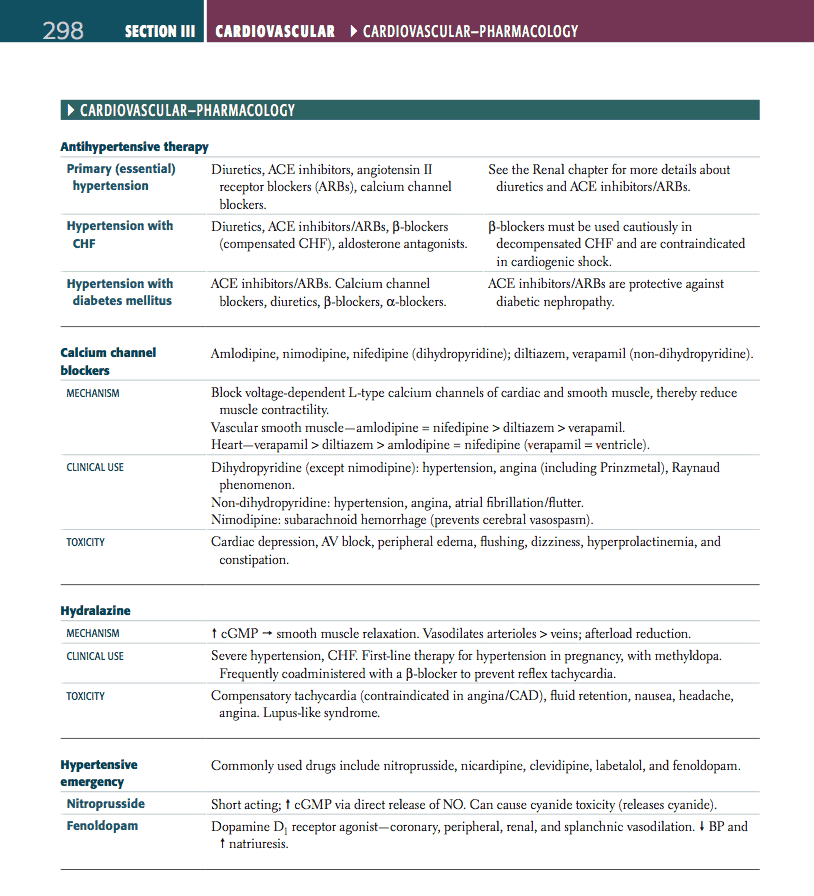

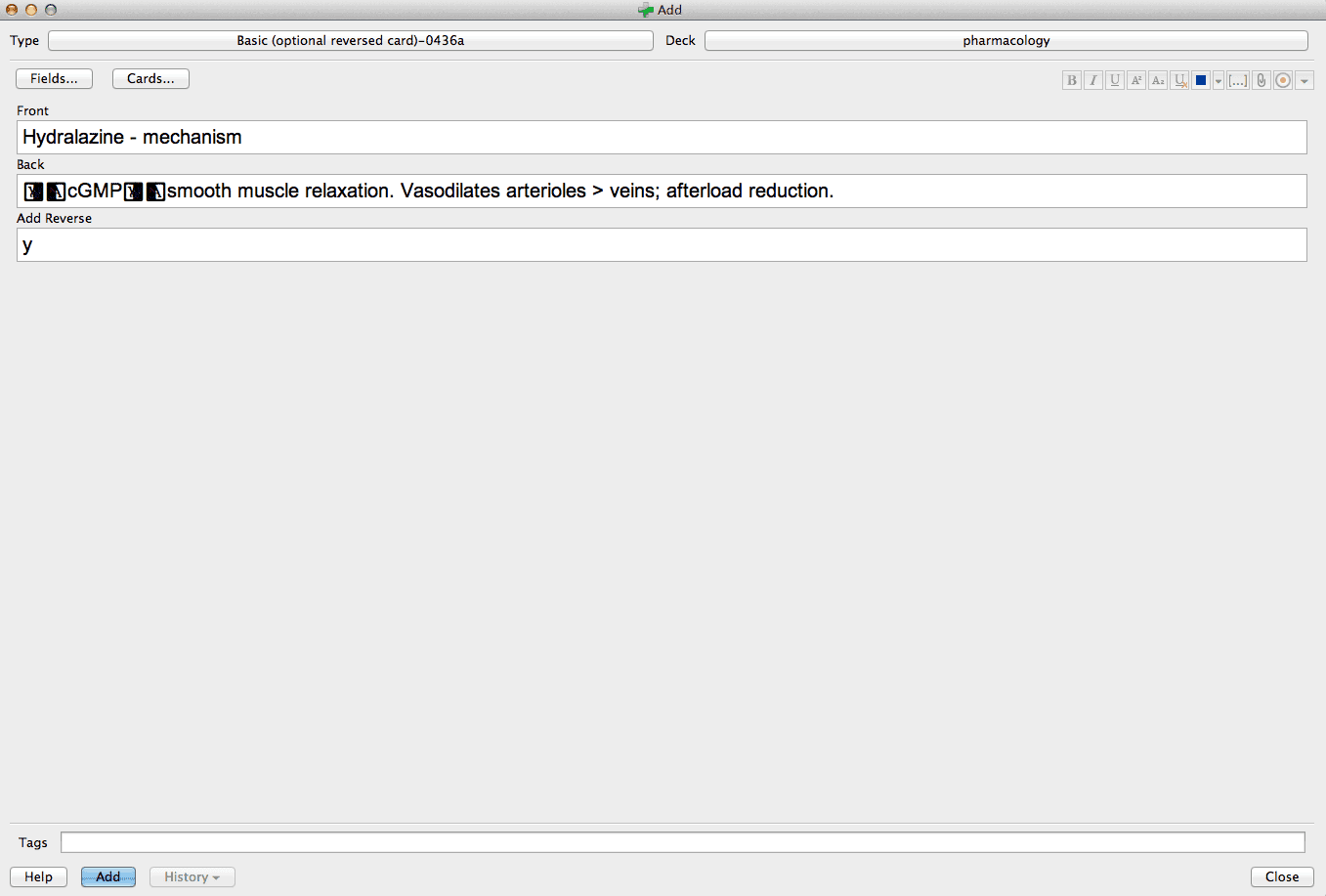
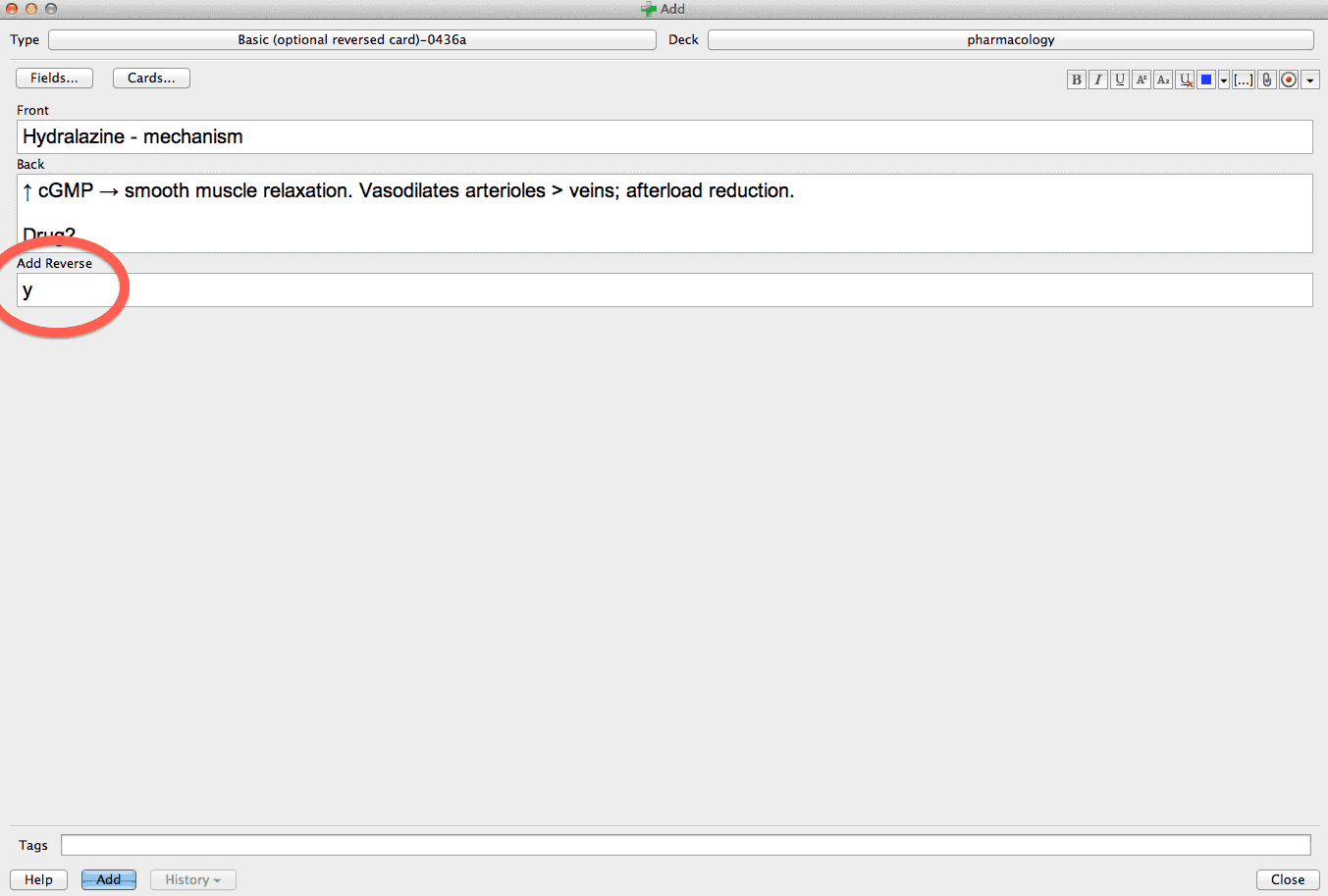
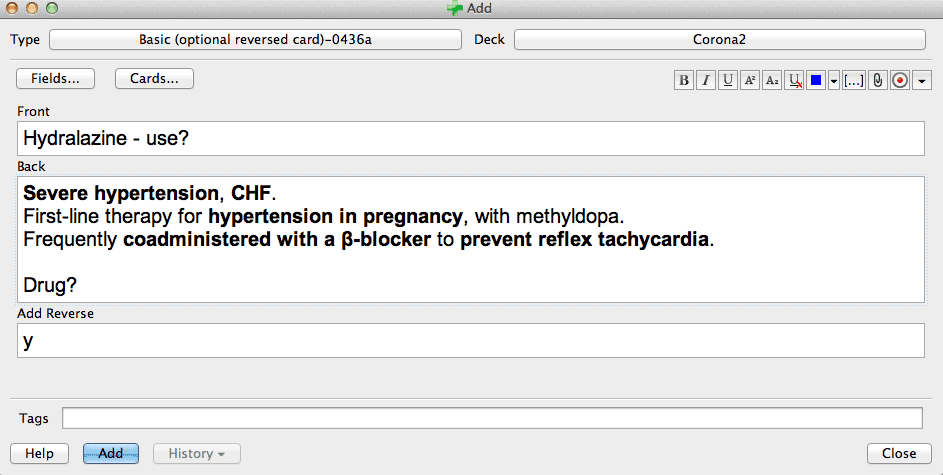
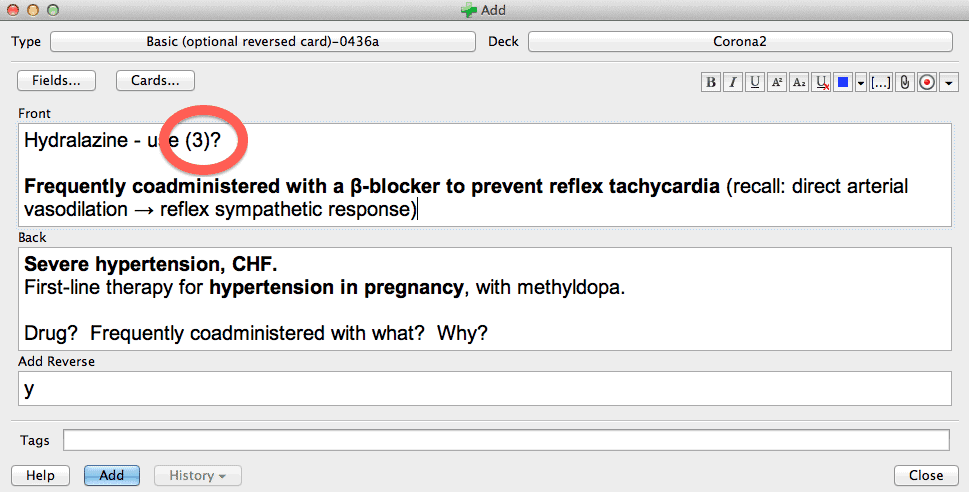
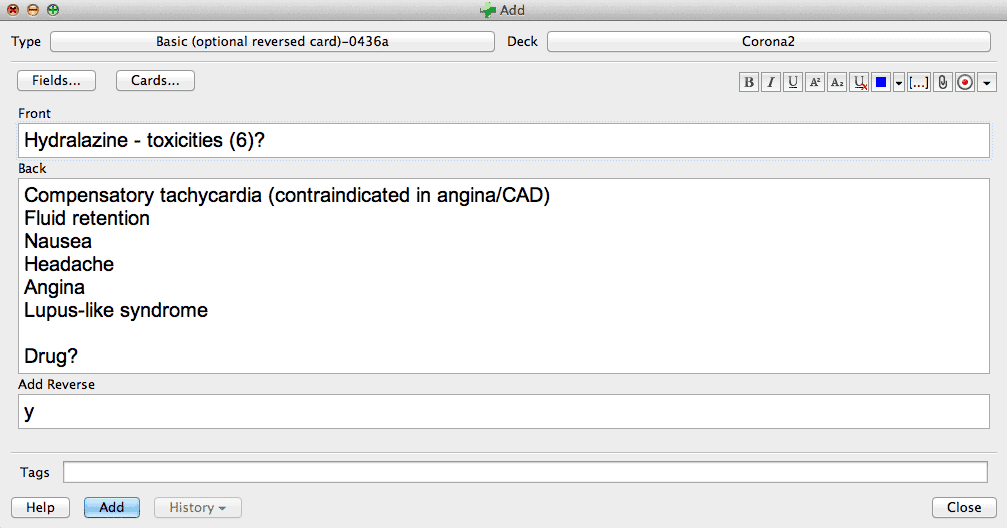
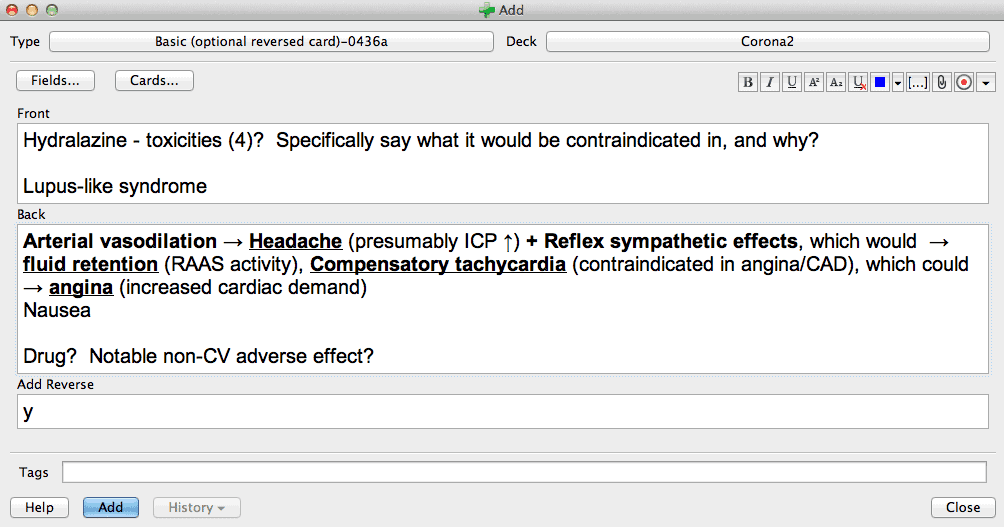
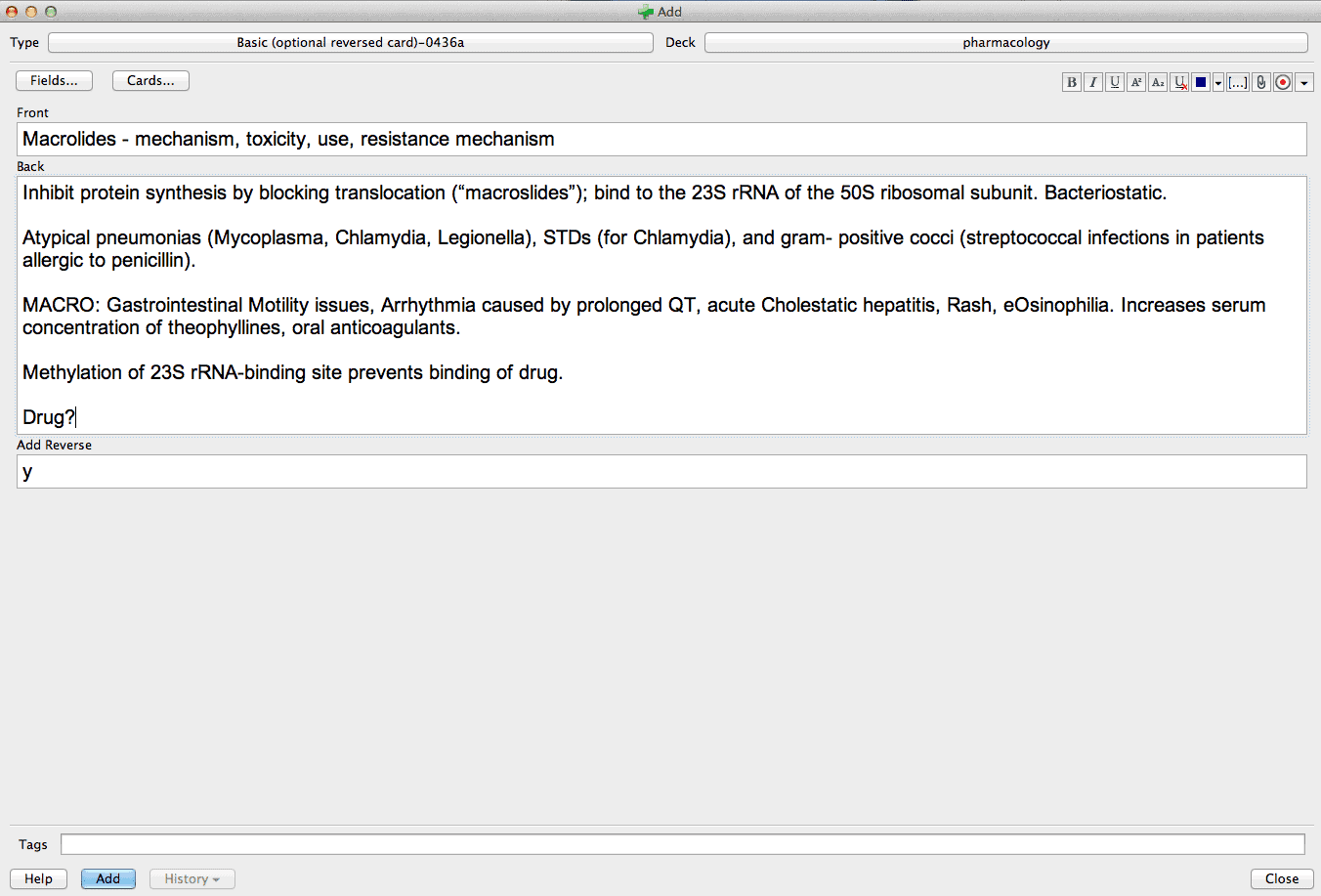







Hey Alex! This is wonderful. I read many of your posts and have really learned a lot.
I was wondering if you had a complete pharm deck? You refer to a pharm deck that you have been working on but I am wondering if it is complete/near complete and available yet?
That would be amazing!
Thanks!
Hi Taylor, thanks for your message. I do indeed have a pharmacology deck, that follows these same principles, which you can find here: https://www.yousmle.com/pharmdeck
Hey Alex,
I have 12 days until my exam. I have scored:
NBME 15 250
NBME 16 252
NBME 17 257
NBME 19 252
I am wondering – Where should I hit home in these last few days?
I want to get over 250, and definitely do not want to go under!
Thanks!
There’s not a whole lot you can change in the last few days. Honestly, I would focus on question interpretation is much as possible. Understanding what every sentence means, and understanding how it relates to the others. If you’re interested in learning more, you can sign up for group tutoring: course.yousmle.com
Hi Alex
I’m Zaid , I’m a medical student and the pharmacology is one of my biggest problems, in our college we don’t study pharm correctly ( focusing mainly on reading classifications and dosing).
I’ve read what you wrote about reading pharm and it is a very effective way , but the question is “” is your method for any student or for student who have a strong base (knowledge) in pharmacology???””
And please what resource(s) that i can recommend for mastering the pharm for usmle step1 exam???
thank you already
This is true for all students learning pharm, regardless of background. I have a pharm deck that I continue to work on, if it interests you in saving time on creating cards in this manner without having to put in all of the time to try and re-create a pharm deck: http://LimitedTimeOffer.co/11378/pharmdeck
Alec
Thanks Alec, I’ll try it.
Another question please about the biochemistry and the behavioral science , what are the books that I should use for the usmle exam??
I used the Rapid Review Biochem book, which I found to be pretty good/concise. For behavioral science/stats some of my students have found the UW stats package useful.
Hey Alec,
“Quick” question, how do you go about making cards for drugs that have the same info (as seen on the FA)? For instance, if I’m making cards for alteplase, reteplase, streptokinase and tenecteplase, which are all thrombolytics, how would you go about making the cards for them? I’m following the guide on your website and making the forward + reverse cards for mechanism, uses and toxicity. If I make cards for all these things for drugs with the same info I would perhaps think of one drug for the card but it’s actually another (e.g. think of alteplase for a card a run into but the actual card is reteplase), though they all do the same. This seems like it’d be a waste of time/frustrating thing to deal with when studying. Would I just make the cards for the drug class (in this case thrombolytics)? Or is there another way of going about making cards for the drugs?
This is especially important/relevant for drug classes with lots of drugs, e.g. macrolides and nucleotide analogs. I’m making a pharma deck for Step 1 so I’d appreciate any help you could provide.
Thanks a lot in advance!
Yep, I’d make one card for the class, and another for the names of the drugs in that class.
This is what I’ve been doing. Glad I’m having the right mentality. Thanks a lot Alec!
One last question, what does “:re” mean in your cards? I always run into something like “disease name and fact :re the protein” or what not. If you could clarify that it’d be great!
I don’t know what that is…re: usually means “regarding”
Ok, that makes sense. I found an example in your biochem deck: “Defect in cystic fibrosis – what does it lead to re: the protein? Why?”. It’d mean “regarding” correct? It does fit in now that I think about it. Sorry for the stupid question. Thanks for your help.
Also, your cards show me how many gaps in knowledge I have overall in my education. Any recommendations in how to address this?
That is correct – Re: = Regarding =)
I’d start with these articles:
https://www.yousmle.com/basic-anki-cards-the-complete-guide-for-med-school-and-the-usmle-step-exams/
https://www.yousmle.com/nail-fundamentals-usmle-step-1-nbme-practice-exams/
https://www.yousmle.com/5-keys-rock-usmle-step-1-anki-spaced-repetition/
https://www.yousmle.com/usmle-world-strategy-step-1-wrong/
https://www.yousmle.com/first-aid-for-the-usmle-step-1-worst-mistake/
Please do not send me emails on “How You Might Fail the USMLE?” I am already frightened at the prospect of taking the exam. I don’t need these demoralizing articles to add to that!! I had tried using your “Anki” software and was not able to do so…So I would really appreciate it if you do not send any articles with negative headlines!!
Hi Alex, I love your website and your approach. Using the example of azithromycin, clarithromycin, erythromycin all being macrocodes, would you just make a “Macrolide-names (3)” flashcard or do the sequence of 6 cards for each one of the three macrolides? thank you!
I’d probably make a card on simply the names of the macrolides, as you suggested first.
Hi, Alex. I bought the app aText, but I couldn’t change the strange symbols when I copy the lines from PDF to anki. Could you help me out with this? Thank you so much!
You have to create replacement symbols, like creating a command like “,bet” to replace it with a symbol like “β.” Unfortunately, there is no way to automatically replace all symbols – you will have to do it manually.
Great information. Do you have an all-inclusive (or “mostly-inclusive”) pharm deck yet? What about micro? I’d be more than happy to pay for a good Anki deck for those two subjects. Thanks!
Thank you so much for your kind words. I am in the process of an all inclusive pharmacology deck, and will be sure to let you know when it is released. I may also work on a microbiology deck if there is enough interest. Thanks again for your feedback, and I look forward to hearing again from you soon!
Alec
Same interest (pharmacologyµbiology) here. And, what about the other subjects like Pathology, Biochemistry…?
You can find those subjects in the Step 1 deck. I will continue to work on a charm-specific deck, however, and will be sure to let you know when it’s done!!
Alec
Great post. So I downloaded aText but have no idea how to go about changing the symbols back to normal, if someone could point me in the right direction or share an article on how to do it I’d really appreciate it!
Great question! I started to compose a response, but it ended up becoming more involved, so I ended up just writing an article. I hope this helps!
http://www.yousmle.com/anki-atext-usmle/
Sorry if this posts twice. I am having trouble pasting from FA and I am hopeful you (or someone reading this) can help. aText is available for Mac only. Is there an equivalent program for PC?
Great website, by the way.
Thank you so much for your kind words! Here is an article that discusses the best options (per Lifehacker):
http://lifehacker.com/5844126/the-best-text-expansion-app-for-windows
hey alec,
thanks for the website!
wanted to get your thoughts about the following:
anki has a feature that lets you make both a forward/reverse card on one click right? your protocol says to make two seperate cards. am i talking about two seperate things?
Thank you for your message. Yes, I would use forward and reverse cards to make 2 separate cards.
I just wanted to say that after discovering your website and techniques,
in the last week alone I have become more efficient in studying for the
Boards than my efforts altogether in the past 2 months! Thank you so
much for all the time and effort you’ve invested into creating the
resources on this site (especially the Heme “cheat sheet” regarding
Warfarin/ the coagulation cascade – which was absolutely brilliant!); it
is one thing to be an exceptional physician, and another to be that
exceptional person who passes on knowledge/self-formulated study
techniques to the benefit of everyone save yourself. I have forwarded
your URL to numerous other students, (some of whom are international
grads, and therefore lack ready access to seniors, or even fellow
batchmates for tips and guidance) and so far the response has been
overwhelmingly positive. The majority of them expressed similar
gratitude after reading your advice, and are now considering tutoring
sessions with you as they near the end of their prep time. So as
collective voice from everyone who has benefited from your work, “Thank
You”. Your efforts are appreciated far more than you may realise. I look
forward to conquering Step 1 with all the guidance you have provided
here, and definitely plan on getting in touch as I near that fateful
date! 🙂
Dear Kimberly,
Thank you so much for your kind words and fantastic feedback! It is comments like these that inspire me to continue to work on better and better ways of helping other students. One of the things I found most frustrating as a student was not having proper guidance on the best ways to learn subjects, as well as how to study for one of the most important tests of my life. I have worked with tons of students in similar situations, and if my experiences can be helpful at all, this has been worth it. Thank you again for your support and for sharing the website with others! I greatly appreciate it ^^
Alec
Hi there, I would like to thank you for the inspiring tips and advice that you are providing us with. I am actually inspired by not only the awesome technique that you are using, but also with the discipline and the consistancy that you are adhering with. I am a man of discipline and I really admire that characteristic in a person.
As for my request, I am a new graduate from Palestine, and I am preparing to sit USMLE step 1 in 2 months. For us (graduates) it’s different to review all that basic medical knowledge since it has been a while. But for now I am doing fine and after reading a couple of your articles I wish I used this method from the beginning. Anyways, I would like to ask you for your Pharmacology deck of cards, since I am having trouble finding the time to create mine, since I need that time to understand some Bio concepts and I only need to revise pharmacology because I think I understood it well back then.
I did try to start making them a week ago, but I am struggling with time and I would like to ask you for help. I know that it will be much better if I made mine, but sadly I have no choice.
Thank you so much for your kind words! I am currently working on a step one deck, but unfortunately do not have a pharmacology deck yet available. I hope to have one in the future, so definitely check back on the website!
Best of luck with your studies!
Sincerely,
Alec
Hey hi! I have no idea how I stumbled upon this but this site just makes things easier. I don’t take my steps in quite a while but m pretty sure these strategies are bound to help in Medical School as well, as I was already facing lots of problems with covering Pharmacology and this helps a lot
So I was wondering how did you manage your time making cards in Medical School and even during that time did you end up revising everything everyday? it just seems like a very difficult fate. But Thank you so much for all the valuable advice 🙂
Hi! Thanks for the fantastic feedback. That is a fantastic question, one that I hope to address soon in an article. My basic goal was to make all cards for subjects I’d learned ON THE SAME DAY. This was hard to do, but ultimately worth it, since it takes so much time to make cards on subjects you have to re-learn. I usually would try and wake up early, too, and make full use of time to make sure I finished my cards before the end of the day. Hope this helps, and I look forward to hearing more feedback of other articles!
Hi Alec! Your method and your individualized approach to us are heavensent, thank you so much for that!
I have been using Anki for the past week now and always at the back of mind I’m asking, “is this high yeild?”. You mentioned in one post that you took note of the educational objectives in UWorld- what about those that are the wrong answers? Did you taken them into consideration too?
Nevertheless, again, I want to thank you for all your insights!
Thank you for your message! My hope with this is to cut through the clutter and provide practical, actionable information that you can use to improve your USMLE/Shelf scores.
I completely understand the desire to put information into Anki that comes from things outside the educational objectives. We’ve ALL done it, for sure.
I typically do NOT put information that isn’t in the educational objectives, unless it helps explain something that I didn’t know previously (e.g. maybe I had just memorized that ACTH was high in congenital adrenal hyperplasia, but didn’t realize that it was because they all have to do with low cortisol → feedback inhibition ↓ → ACTH ↑).
If I learned something new, I would either add that explanation to an existing card, or make a new card. Remember, the key to learning things well for Step 1 is to understand the MECHANISMS of disease. The less you memorize, the more you will be able to apply your knowledge.
If you start putting random information in your cards, you run the risk of making too many cards, which will cause you to have to review lots of cards, which will take more time away from doing QBank questions. Like many things in life, using Anki is a balance, and if you make too many cards, you will spend too much time reviewing less valuable information, while simultaneously be taking away time from other valuable activities.
You might be the exception, but virtually every student I’ve tutored who has made cards on information outside of what was in the educational objective ended up making too many cards, got really behind, and regretted it. Instead, focus on the highest yield information, which they’ve already outlined for you conveniently in the educational objectives!
Man… This stuff is gold. This entire site looks too good to be true (almost). I have my Step 1 in 3 weeks… 3 weeks and 2 days actually. Any advice? I had never known about your site until today…. I wish I heard about this months ago. 🙁
Hi! Thank you so much for your feedback and kind words. I write a lot of this stuff because I got sick of having to rely on forums for information when I was studying for Step 1, and never really knew who to trust or what was the best way to study, etc. I’m glad to see I’m not alone!
As to your question, it really depends on what you are weak on, but the best advice I can give is to slow down and learn how to interpret questions fully, and to focus on your weakest areas and learn them well. You’d be surprised at how many students get questions wrong because they don’t actually understand what the question is asking. EVERY question on the test will depend in part on your ability to understand what the question is asking, so practicing that skill is critical.
I actually wrote an article recently on what to do if you have only a few weeks before your test. If you’d like to read it, the link is below:
http://www.yousmle.com/1-2-weeks-before-your-usmle-step-1/
I would love to hear your feedback on it or any other article you read on the site.
Best of luck!
Although I would reply on that page, even that information is amazing! I just feel disappointed I did not find all this earlier. I feel like I would have been so much further along in my understanding had I used your method. I feel concerned that I cannot formulating cards to use them effectively with a little over 3 weeks left to the exam… I hope I do okay… Thanks for this awesome resource, though. Not sure how more people aren’t aware of it.
Thank you so much for your reply. I agree with your instinct that more time would help to implement this strategy more effectively. The biggest mistake people make is that they get SO excited about this strategy that they try and put everything into Anki cards…and then get overwhelmed with everything they have to do and don’t actually get to finish their cards.
As such, my best advice would be to have more modest goals with it. 3 weeks isn’t a ton of time, so I’d just focus on making good, basic cards, and try to avoid making the same mistake twice on QBank questions. Use the USMLE Step 1 Cheat Sheets on this site for topics you feel particularly weak, and copy and paste the questions you don’t know into your Anki cards, especially the questions at the end.
Here’s the link to the basic card making guide: http://www.yousmle.com/basic-anki-cards-the-complete-guide-for-med-school-and-the-usmle-step-exams/
Again, I really appreciate your feedback, and want to help as much as I can to simplify what it takes to do well on Step 1!
I sent you an email. Did you happen to receive it?
Yep!
is it possible for you to upload the rest of your anki pharm cards?
Hi Arfan – thank you for your message. Unfortunately, I was not the most organized when I made my pharm cards, so I don’t have a reliable way of uploading only my pharm cards. Additionally, even if I did, there would be LOTS of “lower-yield” cards mixed in, since I made these cards throughout my first and second years. I will continue to upload more and more cards as I organize them, so I encourage you to check out the many articles where I DO share Anki cards, as well as to check back in the future! Thanks for your question!